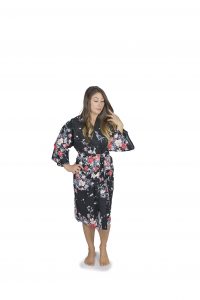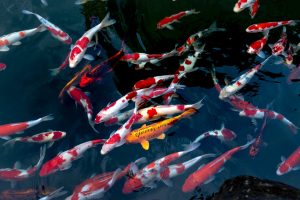Chinese Kimono? I thought Kimonos came from Japan?
Does this sound familiar? If you are shopping for an authentic Japanese kimono, you should become familiar with the games and tricks that some dealers use. The kimono was created in Japan and is still the hallmark of Japanese-inspired clothing today. Kimono was once commonly worn with Chinese-influenced hakama, which is a type of long skirt. If the hakama had dividers separating the legs, they were similar to pants. Some believe that because this combo was worn well over 1000 years ago, kimonos originated in China, but that is not the case.
To connoisseurs of kimono and yukata robes, nothing says “kimono” like “Made in Japan.” It is fairly easy to determine if a vendor is selling a true Japanese kimono. We see ads frequently that mask the true origination or disguise the fact they are made elsewhere. There is only one authentic kimono and those are made in Japan.
Not a week passes that we receive an email from a customer feeling betrayed or cheated by a kimono they purchased online. They thought they were buying a garment made in Japan, but in reality, it was a Chinese-made knock-off. This isn’t to say the quality isn’t adequate or that it can’t be called a kimono, but calling it a Japanese kimono is simply wrong. Why would dealers do this? To make more money and to sell a disguised counterfeit product to unsuspecting buyers.
Selling platforms like Amazon and Etsy need to do a better job enforcing “Truth in Advertising” laws and rules. Chopa has always had strong ethics and believes in being completely honest with our customers and non-customers. We have done so for over 28 years which we believe is one of the reasons we are still thriving in business today. We would never want to jeopardize our reputation or trick a customer just to make a buck.
There are unscrupulous dealers online and we are happy when customer writes us to tell us what a great experience they had shopping in our online Kimono Shop and how much they like the kimono. Unfortunately we receive those stories from customers that shopped elsewhere needing someone to talk to or help them if any remedy is possible.
A major rule of thumb in locating a Japanese Kimono are the words, “Made in Japan.” After all how much simpler can it get? If it is made there, it should say so in the description. Instead you will find Japanese Style, Japanese Inspired, or a blatant use of Japanese Kimono even when it isn’t made in Japan. Take a look at Amazon or Etsy and you can determine where it is made. Look for “ships from Bali” or a Chinese named business.
Checking on Amazon’s reviews allows you to discover what other customers already did. Here is a sampling of random reviews we found that say it all.
“The reviews here are misleading. It is not made in Japan.” – 2/11/21
“Needs to be washed. My complaint is the fabric is stiff and scratchy.” – 7/14/20
“Sending it back. The description and Q&A led me to believe this was made in Japan. The first thing I noticed when I opened the box was a Made in China tag.” – 9/01/19
“The kimono I received has a Made in China tag. I am very disappointed.” – 8/30/19
Those are very self-explanatory but one of our favorites (being sarcastic here) is the one review that states that the “Made in China isn’t an issue. This is a Japanese brand that is made in China for Japanese markets, it is not a knock-off.” We would assume this was written by the dealer themselves. We have never heard of such ridiculous reasoning. There is no such thing. It’s just a ploy.
If you have any questions about buying a kimono, we of course welcome you to visit our online kimono Shop. Browse around, look at the different styles and know that all of our robes are finely crafted in Japan and imported directly to the USA for the enjoyment of our customers. We don’t make up stories, we don’t exaggerate and we don’t hide vital information.
Don’t ever assume that because a dealer says Japanese Kimono it is made in Japan. If it is, the dealer should say so, clearly and directly in the description, just like we do. Send us questions or stories you have about your shopping experience whether with us or another source. If we can guide you down the right path, we will certainly do so.
Some dealers on the web do unscrupulous things to compete in the online world of retail. One of our upcoming blogs will be about discovering that a competitor stole and published over two dozen copyrighted images from our website to use on their own site. No permission, no licensing agreement, no request, just blatant theft. If a retailer openly steals images, what else would they steal from you in the process of a sale?






